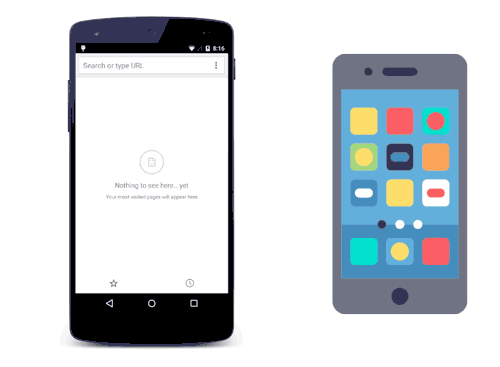According to Google, Progressive Web Apps are experiences that combine the best of both worlds – the web and mobile apps. They are useful to users from the very first visit in a browser tab, no install required. As the user progressively builds a relationship with the app over time, it becomes more and more powerful. It loads quickly, even on flaky networks, sends relevant push notifications, has an icon on the home screen, and loads as a top-level, full-screen experience.
Importance of Progressive Web Apps Tracking:
PWA is much more than a hot buzzword right now. It can resolve all your issues right from delivering a faster loading mobile website, decrease your page load time on it and also give you insights as to how much time it takes for a customer to book something from your mobile site. But, do you ever find yourself asking “What about Google Analytics implementation? How will that work in such dynamic sites? What about pageviews, sessions, source/medium? Well, we have all the answers on how to implement Google Analytics for PWA for you right here in this blog, read on to find out.
In this blog post, we are going to focus on achieving tangible benefits to your critical business KPIs through PWA.
Progressive Web Apps, in simple terms, is bringing an app into a mobile web in a revolutionary format. It can run on a reliable or even low internet connections, which will enable users to have quick access and will also help your business grow when compared to your native site.
Standard vs PWA pages
In today’s fast speed 4G times, every user is on the lookout to have quick access to the information or product he’s in search for. A survey by SplitMetrics suggests that an average of merely 26.4% of users that visit your app store page will install your app and other 73.6% of users are simply lost.
Many times users bounce immediately if a page takes a long time to load. By using PWA, there are many benefits across different verticals in terms of their user engagement and conversion rate.
Here’s how implementing and tracking PWA helps different verticals:
- Digital Publisher: If you are implementing PWA, you can definitely improve the effectiveness in terms of increasing the average time spent on page and the number of pageviews. This would also translate into a significant decrease in terms of bounce rate and page load time.
- E-commerce: PWA can enable eCommerce businesses to increase the effectiveness in terms of a better conversion rate that translates into an increase in sales.
- Lead Generation: Optimize the effectiveness in terms of page load time and increase in leads
Image2: Difference between PWA and Native M-Web
Use Cases:
1) Increase in the Time Spent on Page:
One of our clients is a digital publisher. They were experiencing a majority of incoming traffic on their mobile site but the engagement metrics were way less than that on Desktop. We identified that the reasons behind these were the high bounce rates and very short session durations. Contributing to these was the high average page load time when compared to other devices.
Once we understood their problem, our team suggested that the better approach to reducing page load time is to implement PWA. Tatvic provided complete support in the tracking and implementation process. It was then rolled out to 10% of the traffic so as to verify the user engagement metrics. The outcome was much more than our set expectations. We observed a sudden rise in user engagement which resulted in less page load time and users are spending more time.
2) The decrease in Bounce Rates:
With a strong decrease in desktop growth, one of our lead generation clients gets over 85% of their traffic from mobile devices and still in increasing trend. Most of their visitors come in from their native app and the rest all via their mobile website. However, their mobile site bounce rate kept getting higher day by day.
We analyzed the mobile site behavior and realized that their UI experience was too slow on Mobile. However, we observed that client is focused on acquiring quality users and growing their user engagement on the mobile web through Google Analytics data. We then looked into PWA as an alternative solution which provides a faster-loading and a similar experience like an App.
Client focused to re-engage for mobile site users, instead of acquiring new traffic. As a best practice, we suggested them to shift to PWA site altogether and also helped them with their tracking requirements. With just these two updates, their user engagement increased by double as opposed to the native mobile site which in turn increased their leads as well.
3) Optimization of Revenue and Conversation rate:
A popular eCommerce business was facing the challenge of a low conversion rate. They generally experience incoming traffic largely from their mobile website. Our team identified the pain point with the help of Google Analytics 360. The insights drawn from the analysis was that users with low internet speed experience a high page load time. This resulted in a low conversion rate.
However, thanks to our long-standing relationship with the client, we suggested our client implement PWA rather than working towards optimizing their mobile website. They shifted to a Progressive Web Apps site for 5% of users. Gradually, they experienced a dramatic change of 50% increase in their conversion rate.
Concluding Thoughts:
To conclude, PWA has shown all the traits that it has the potential power of becoming the future of Mobile websites. Ensure your users are better engaged and the journey isn’t broken prematurely. With the real life use cases shared in this blog, we aim to give you a better sense of how implementing Google Analytics for PWA has great impacts on your business.
Check out our webinar on Progressive Web Apps (PWA) Analytics Tracking with Google Analytics. Register today to ensure you don’t miss out on an awesome session.
If you’ve any queries, doubts or you need any help, please leave a comment below, we’d love to hear from you!



